Socioeconomic and Environmental Impacts on Regional Tourism across Chinese Cities: A Spatiotemporal Heterogeneous Perspective
Abstract
:1. Introduction
2. Materials and Methods
2.1. Study Area and Data
2.2. Statistical Methods
2.2.1. Variable Selection
2.2.2. Bayesian STVC Model
2.2.3. Model Implementation and Comparison
2.2.4. Model Inference and Evaluation
3. Results
3.1. Selected Drivers for Modeling
3.2. Model Assessment and Comparison
3.3. Global-Scale Impacts of Drivers
3.4. Temporally Varying Impacts of Drivers
3.5. Spatially Varying Impacts of Drivers
3.6. Spatiotemporal Estimated Maps of China’s City-Level Tourism Revenue
4. Discussion
5. Conclusions
Author Contributions
Funding
Data Availability Statement
Conflicts of Interest
Appendix A
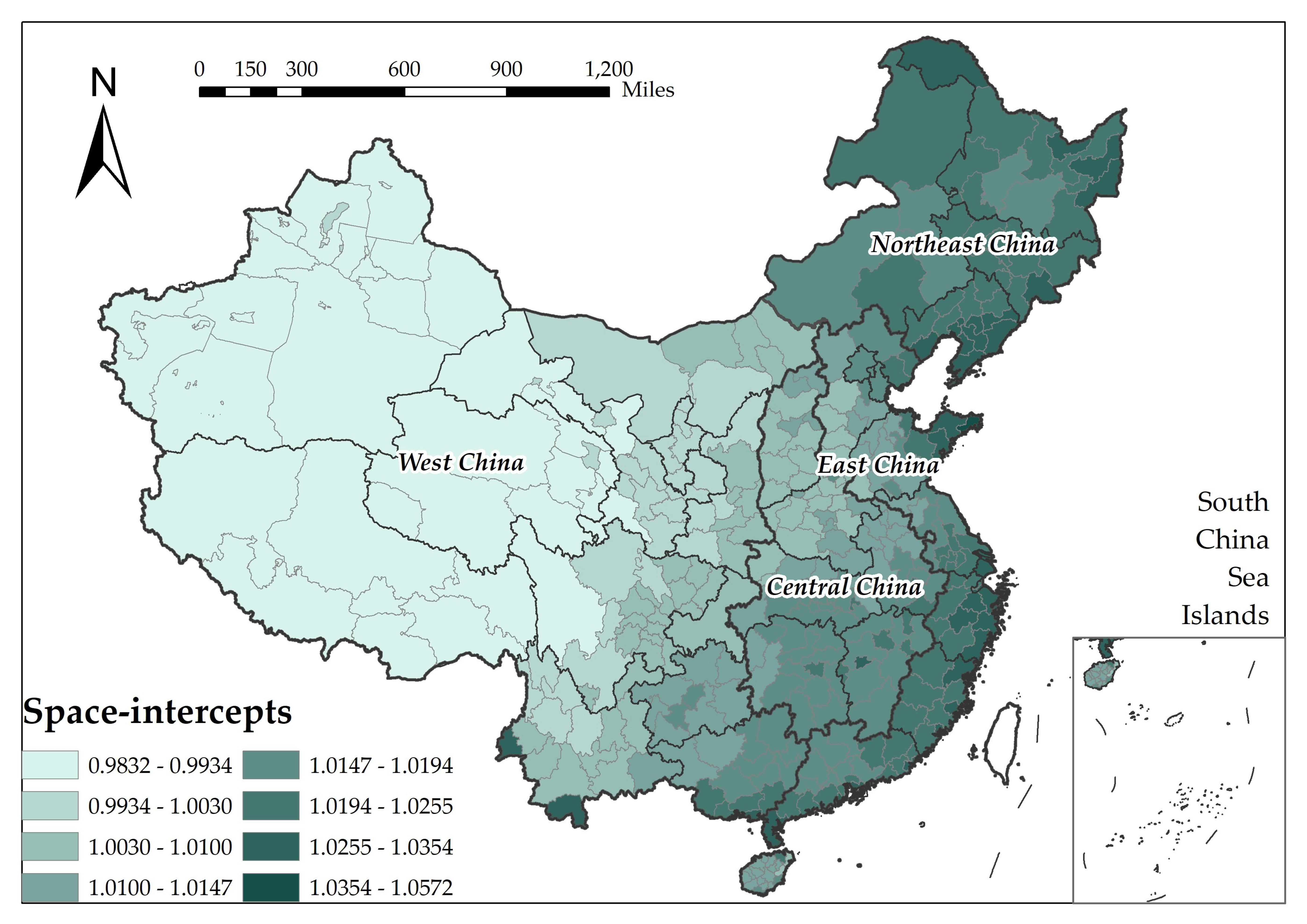
References
- Fayissa, B.; Nsiah, C.; Tadasse, B. Impact of tourism on economic growth and development in Africa. Tour. Econ. 2008, 14, 807–818. [Google Scholar] [CrossRef] [Green Version]
- Travel & Tourism Global Economic Impact & Issues 2017. Available online: https://wttc.org/Portals/0/Documents/Reports/2020/Global%20Economic%20Impact%20Trends%202020.pdf?ver=2021-02-25-183118-360 (accessed on 6 June 2021).
- Modeste, N.C. The impact of growth in the tourism sector on economic development: The experience of selected Caribbean countries. Econ. Internazionale/Int. Econ. 1995, 48, 375–385. [Google Scholar]
- Proença, S.; Soukiazis, E. Tourism as an economic growth factor: A case study for Southern European countries. Tour. Econ. 2008, 14, 791–806. [Google Scholar] [CrossRef]
- Ma, T.; Hong, T.; Zhang, H. Tourism spatial spillover effects and urban economic growth. J. Bus. Res. 2015, 68, 74–80. [Google Scholar] [CrossRef]
- Coccossis, H. Tourism and sustainability: Perspectives and implications. In Sustainable Tourism? European Experiences; CAB INTERNATIONAL: Wallingford, UK, 1996; pp. 1–21. [Google Scholar]
- Joshi, O.; Poudyal, N.C.; Larson, L.R. The influence of sociopolitical, natural, and cultural factors on international tourism growth: A cross-country panel analysis. Environ. Dev. Sustain. 2017, 19, 825–838. [Google Scholar] [CrossRef]
- Khan, A.; Bibi, S.; Ardito, L.; Lyu, J.; Hayat, H.; Arif, A.M. Revisiting the Dynamics of Tourism, Economic Growth, and Environmental Pollutants in the Emerging Economies—Sustainable Tourism Policy Implications. Sustainability 2020, 12, 2533. [Google Scholar] [CrossRef] [Green Version]
- Tuckova, Z.; Sverak, P. Impact of the Regional Macroeconomics Indicators on Tourism Entities in Plzen and Zlin Regions. Procedia Econ. Financ. 2016, 39, 313–318. [Google Scholar] [CrossRef] [Green Version]
- Jarvis, D.; Stoeckl, N.; Liu, H.-B. The impact of economic, social and environmental factors on trip satisfaction and the likelihood of visitors returning. Tour. Manag. 2016, 52, 1–18. [Google Scholar] [CrossRef] [Green Version]
- Jayaraman, K.; Lin, S.K.; Haron, H.; Ong, W.L. Macroeconomic factors influencing Malaysian tourism revenue, 2002–2008. Tour. Econ. 2011, 17, 1347–1363. [Google Scholar] [CrossRef]
- Alonso-Almeida, M.d.M.; Borrajo-Millán, F.; Yi, L. Are social media data pushing overtourism? The case of Barcelona and Chinese tourists. Sustainability 2019, 11, 3356. [Google Scholar] [CrossRef] [Green Version]
- Field, C.B.; Barros, V.R. Climate Change 2014-Impacts, Adaptation and Vulnerability: Part A: Global and Sectoral Aspects: Volume 1, Global and Sectoral Aspects: Working Group II Contribution to the IPCC Fifth Assessment Report; Cambridge University Press: Cambridge, UK, 2014. [Google Scholar]
- Hewer, M.J.; Gough, W.A. Thirty years of assessing the impacts of climate change on outdoor recreation and tourism in Canada. Tour. Manag. Perspect. 2018, 26, 179–192. [Google Scholar] [CrossRef]
- Martín, M.B.G. Weather, climate and tourism a geographical perspective. Ann. Tour. Res. 2005, 32, 571–591. [Google Scholar] [CrossRef]
- Day, J.; Chin, N.; Sydnor, S.; Cherkauer, K. Weather, climate, and tourism performance: A quantitative analysis. Tour. Manag. Perspect. 2013, 5, 51–56. [Google Scholar] [CrossRef]
- Smith, T.; Fitchett, J.M. Drought challenges for nature tourism in the Sabi Sands Game Reserve in the eastern region of South Africa. Afr. J. Range Forage Sci. 2020, 37, 107–117. [Google Scholar] [CrossRef]
- Atzori, R.; Fyall, A.; Miller, G. Tourist responses to climate change: Potential impacts and adaptation in Florida’s coastal destinations. Tour. Manag. 2018, 69, 12–22. [Google Scholar] [CrossRef]
- Susanto, J.; Zheng, X.; Liu, Y.; Wang, C. The impacts of climate variables and climate-related extreme events on island country’s tourism: Evidence from Indonesia. J. Clean. Prod. 2020, 276, 124204. [Google Scholar] [CrossRef]
- Kanwal, S.; Rasheed, M.I.; Pitafi, A.H.; Pitafi, A.; Ren, M. Road and transport infrastructure development and community support for tourism: The role of perceived benefits, and community satisfaction. Tour. Manag. 2020, 77, 104014. [Google Scholar] [CrossRef]
- Li, L.S.; Yang, F.X.; Cui, C. High-speed rail and tourism in China: An urban agglomeration perspective. Int. J. Tour. Res. 2019, 21, 45–60. [Google Scholar] [CrossRef] [Green Version]
- Barkauskas, V.; Barkauskienė, K.; Jasinskas, E. Analysis of macro environmental factors influencing the development of rural tourism: Lithuanian case. Procedia Soc. Behav. Sci. 2015, 213, 167–172. [Google Scholar] [CrossRef] [Green Version]
- Marrocu, E.; Paci, R.; Zara, A. Micro-economic determinants of tourist expenditure: A quantile regression approach. Tour. Manag. 2015, 50, 13–30. [Google Scholar] [CrossRef]
- Li, M.; Fang, L.; Huang, X.; Goh, C. A spatial–temporal analysis of hotels in urban tourism destination. Int. J. Hosp. Manag. 2015, 45, 34–43. [Google Scholar] [CrossRef] [PubMed]
- Gutiérrez, J.; García-Palomares, J.C.; Romanillos, G.; Salas-Olmedo, M.H. The eruption of Airbnb in tourist cities: Comparing spatial patterns of hotels and peer-to-peer accommodation in Barcelona. Tour. Manag. 2017, 62, 278–291. [Google Scholar] [CrossRef] [Green Version]
- Xu, D.; Huang, Z.; Hou, G.; Zhang, C. The spatial spillover effects of haze pollution on inbound tourism: Evidence from mid-eastern China. Tour. Geogr. 2020, 22, 83–104. [Google Scholar] [CrossRef]
- Brunsdon, C.; Fotheringham, S.; Charlton, M. Geographically weighted regression. J. R. Stat. Soc. Ser. D 1998, 47, 431–443. [Google Scholar] [CrossRef]
- Yang, Y.; Fik, T. Spatial effects in regional tourism growth. Ann. Tour. Res. 2014, 46, 144–162. [Google Scholar] [CrossRef] [Green Version]
- Shabrina, Z.; Buyuklieva, B.; Ng, M.K.M. Short-Term Rental Platform in the Urban Tourism Context: A Geographically Weighted Regression (GWR) and a Multiscale GWR (MGWR) Approaches. Geogr. Anal. 2020. [Google Scholar] [CrossRef]
- Lu, L.; Yu, F. A study on the spatial characteristic of provincial difference of tourism economy. Econ. Geogr. 2005, 3, 406–410. [Google Scholar]
- Li, H.; Chen, J.L.; Li, G.; Goh, C. Tourism and regional income inequality: Evidence from China. Ann. Tour. Res. 2016, 58, 81–99. [Google Scholar] [CrossRef]
- Yang, Y. Agglomeration density and tourism development in China: An empirical research based on dynamic panel data model. Tour. Manag. 2012, 33, 1347–1359. [Google Scholar] [CrossRef]
- Gan, C.; Voda, M.; Wang, K.; Chen, L.; Ye, J. Spatial network structure of the tourism economy in urban agglomeration: A social network analysis. J. Hosp. Tour. Manag. 2021, 47, 124–133. [Google Scholar] [CrossRef]
- Wang, D.; Ap, J. Factors affecting tourism policy implementation: A conceptual framework and a case study in China. Tour. Manag. 2013, 36, 221–233. [Google Scholar] [CrossRef]
- Song, C.; Shi, X.; Bo, Y.; Wang, J.; Wang, Y.; Huang, D. Exploring spatiotemporal nonstationary effects of climate factors on hand, foot, and mouth disease using Bayesian Spatiotemporally Varying Coefficients (STVC) model in Sichuan, China. Sci. Total Environ. 2019, 648, 550–560. [Google Scholar] [CrossRef] [PubMed]
- Song, C.; Shi, X.; Wang, J. Spatiotemporally Varying Coefficients (STVC) model: A Bayesian local regression to detect spatial and temporal nonstationarity in variables relationships. Ann. GIS 2020, 1–15. [Google Scholar] [CrossRef]
- Liaw, A.; Wiener, M. Classification and regression by randomForest. R News 2002, 2, 18–22. [Google Scholar]
- Vatcheva, K.P.; Lee, M.; McCormick, J.B.; Rahbar, M.H. Multicollinearity in regression analyses conducted in epidemiologic studies. Epidemiology 2016, 6, 227. [Google Scholar] [CrossRef] [PubMed] [Green Version]
- Song, C.; He, Y.; Bo, Y.; Wang, J.; Ren, Z.; Guo, J.; Yang, H. Disease relative risk downscaling model to localize spatial epidemiologic indicators for mapping hand, foot, and mouth disease over China. Stoch. Environ. Res. Risk Assess. 2019, 33, 1815–1833. [Google Scholar] [CrossRef]
- Breiman, L. Random forests. Mach. Learn. 2001, 45, 5–32. [Google Scholar] [CrossRef] [Green Version]
- Genuer, R.; Poggi, J.-M.; Tuleau-Malot, C. Variable selection using random forests. Pattern Recognit. Lett. 2010, 31, 2225–2236. [Google Scholar] [CrossRef] [Green Version]
- Blangiardo, M.; Cameletti, M. Spatial and Spatio-Temporal Bayesian Models with R-INLA; John Wiley & Sons: Hoboken, NJ, USA, 2015. [Google Scholar]
- Martínez-Bello, D.A.; López-Quílez, A.; Torres Prieto, A. Spatio-temporal modeling of Zika and dengue infections within Colombia. Int. J. Environ. Res. Public Health 2018, 15, 1376. [Google Scholar] [CrossRef] [Green Version]
- Lindgren, F.; Rue, H. Bayesian spatial modelling with R-INLA. J. Stat. Softw. 2015, 63, 1–25. [Google Scholar] [CrossRef] [Green Version]
- Besag, J. Spatial interaction and the statistical analysis of lattice systems. J. R. Stat. Soc. Ser. B 1974, 36, 192–225. [Google Scholar] [CrossRef]
- Blangiardo, M.; Cameletti, M.; Baio, G.; Rue, H. Spatial and spatio-temporal models with R-INLA. Spat. Spatio Temporal Epidemiol. 2013, 4, 33–49. [Google Scholar] [CrossRef] [Green Version]
- Wang, X.; Yue, Y.; Faraway, J.J. Bayesian Regression Modeling with INLA; Chapman and Hall/CRC: London, UK, 2018. [Google Scholar]
- Hastie, T.J.; Tibshirani, R.J. Generalized Additive Models; CRC Press: Boca Raton, FL, USA, 1990; Volume 43. [Google Scholar]
- Ugarte, M.D.; Adin, A.; Goicoa, T.; Militino, A.F. On fitting spatio-temporal disease mapping models using approximate Bayesian inference. Stat. Methods Med Res. 2014, 23, 507–530. [Google Scholar] [CrossRef]
- Song, C.; Wang, Y.; Yang, X.; Yang, Y.; Tang, Z.; Wang, X.; Pan, J. Spatial and Temporal Impacts of Socioeconomic and Environmental Factors on Healthcare Resources: A County-Level Bayesian Local Spatiotemporal Regression Modeling Study of Hospital Beds in Southwest China. Int. J. Environ. Res. Public Health 2020, 17, 5890. [Google Scholar] [CrossRef]
- Rue, H.; Martino, S.; Chopin, N. Approximate Bayesian inference for latent Gaussian models by using integrated nested Laplace approximations. J. R. Stat. Soc. Ser. B 2009, 71, 319–392. [Google Scholar] [CrossRef]
- Rue, H.; Riebler, A.; Sørbye, S.H.; Illian, J.B.; Simpson, D.P.; Lindgren, F.K. Bayesian computing with INLA: A review. Annu. Rev. Stat. Its Appl. 2017, 4, 395–421. [Google Scholar] [CrossRef] [Green Version]
- Spiegelhalter, D.J.; Best, N.G.; Carlin, B.P.; Van Der Linde, A. Bayesian measures of model complexity and fit. J. R. Stat. Soc. Ser. B 2002, 64, 583–639. [Google Scholar] [CrossRef] [Green Version]
- Held, L.; Schrödle, B.; Rue, H. Posterior and cross-validatory predictive checks: A comparison of MCMC and INLA. In Statistical Modelling and Regression Structures; Springer: Cham, Switzerland, 2010; pp. 91–110. [Google Scholar]
- Wang, J.; Huang, X.; Gong, Z.; Cao, K. Dynamic assessment of tourism carrying capacity and its impacts on tourism economic growth in urban tourism destinations in China. J. Destin. Mark. Manag. 2020, 15, 100383. [Google Scholar] [CrossRef]
- Gu, M.; Wong, P.P. Residents’ perception of tourism impacts: A case study of homestay operators in Dachangshan Dao, North-East China. Tour. Geogr. 2006, 8, 253–273. [Google Scholar] [CrossRef]
- Yin, P.; Lin, Z.; Prideaux, B. The impact of high-speed railway on tourism spatial structures between two adjoining metropolitan cities in China: Beijing and Tianjin. J. Transp. Geogr. 2019, 80, 102495. [Google Scholar] [CrossRef]
- Li, J. Research on the Development of Coastal Rural Tourism in China from the Perspective of Industrial Integration. J. Coast. Res. 2020, 115, 271–273. [Google Scholar] [CrossRef]
- Lin, V.S.; Qin, Y.; Li, G.; Wu, J. Determinants of Chinese households’ tourism consumption: Evidence from China Family Panel Studies. Int. J. Tour. Res. 2020. [Google Scholar] [CrossRef]
- Pratt, S. Potential economic contribution of regional tourism development in China: A comparative analysis. Int. J. Tour. Res. 2015, 17, 303–312. [Google Scholar] [CrossRef]
- Fang, L. Empirical Research on the Impact of Urbanization on Regional Tourism Economy in China Basing on Panel Data. In Proceedings of the 2018 9th International Conference on E-Business, Management and Economics, Waterloo, ON, Canada, 2–4 August 2018; pp. 101–105. [Google Scholar]
- Luo, J.M.; Qiu, H.; Goh, C.; Wang, D. An analysis of tourism development in China from urbanization perspective. J. Qual. Assur. Hosp. Tour. 2016, 17, 24–44. [Google Scholar] [CrossRef]
- Fotheringham, A.S.; Crespo, R.; Yao, J. Geographical and temporal weighted regression (GTWR). Geogr. Anal. 2015, 47, 431–452. [Google Scholar] [CrossRef] [Green Version]
- Huang, B.; Wu, B.; Barry, M. Geographically and temporally weighted regression for modeling spatio-temporal variation in house prices. Int. J. Geogr. Inf. Sci. 2010, 24, 383–401. [Google Scholar] [CrossRef]
- Wu, C.; Ren, F.; Hu, W.; Du, Q. Multiscale geographically and temporally weighted regression: Exploring the spatiotemporal determinants of housing prices. Int. J. Geogr. Inf. Sci. 2019, 33, 489–511. [Google Scholar] [CrossRef]
- Jiang, H.; Hu, H.; Li, B.; Zhang, Z.; Wang, S.; Lin, T. Understanding the non-stationary relationships between corn yields and meteorology via a spatiotemporally varying coefficient model. Agric. For. Meteorol. 2021, 301, 108340. [Google Scholar] [CrossRef]
- Wolf, L.J.; Oshan, T.M.; Fotheringham, A.S. Single and multiscale models of process spatial heterogeneity. Geogr. Anal. 2018, 50, 223–246. [Google Scholar] [CrossRef] [Green Version]
- Finley, A.O. Comparing spatially-varying coefficients models for analysis of ecological data with non-stationary and anisotropic residual dependence. Methods Ecol. Evol. 2011, 2, 143–154. [Google Scholar] [CrossRef]
- E Silva, F.B.; Herrera, M.A.M.; Rosina, K.; Barranco, R.R.; Freire, S.; Schiavina, M. Analysing spatiotemporal patterns of tourism in Europe at high-resolution with conventional and big data sources. Tour. Manag. 2018, 68, 101–115. [Google Scholar] [CrossRef]
- Duca, A.L.; Marchetti, A. Open data for tourism: The case of Tourpedia. J. Hosp. Tour. Technol. 2019, 10, 351–368. [Google Scholar]
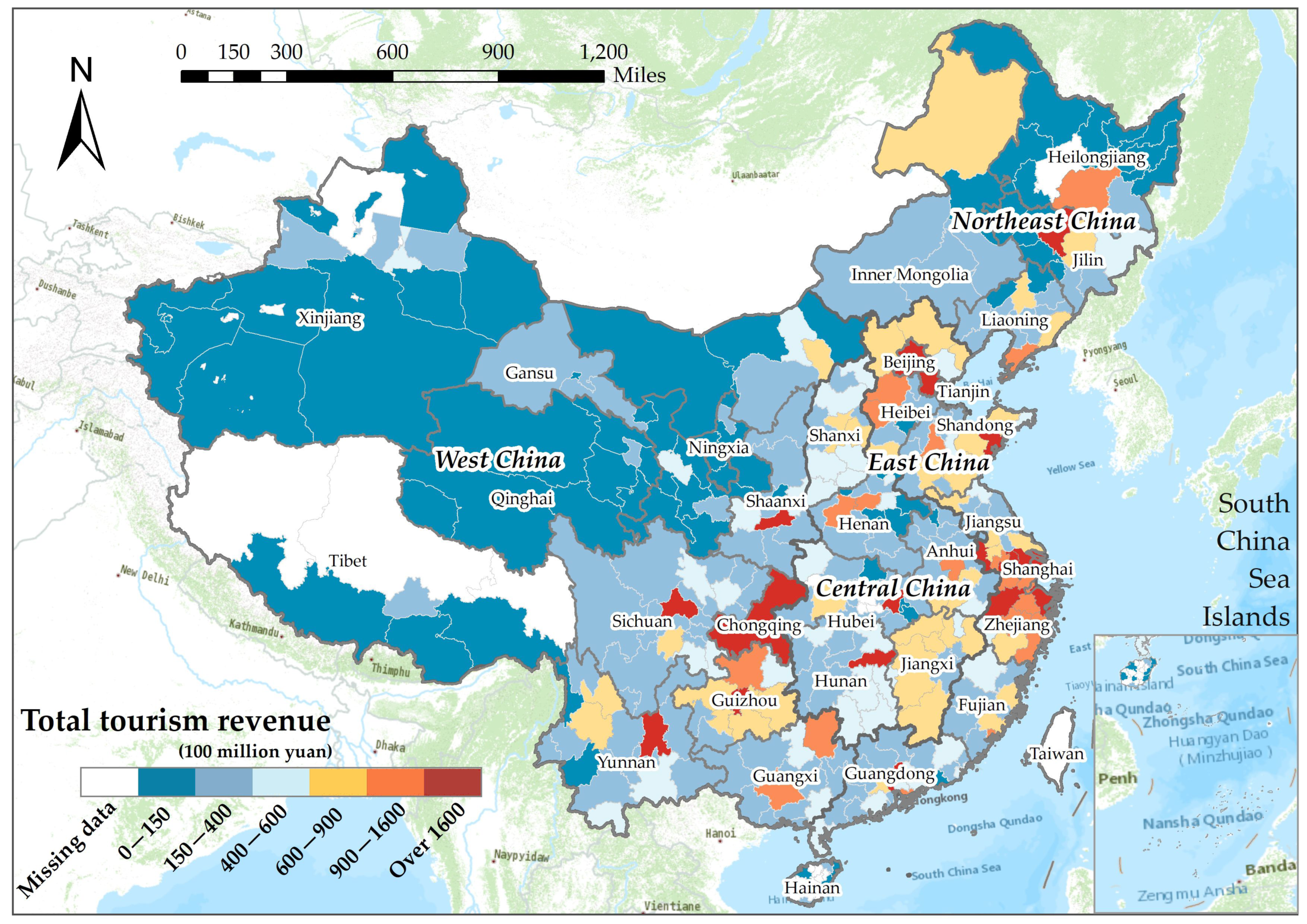
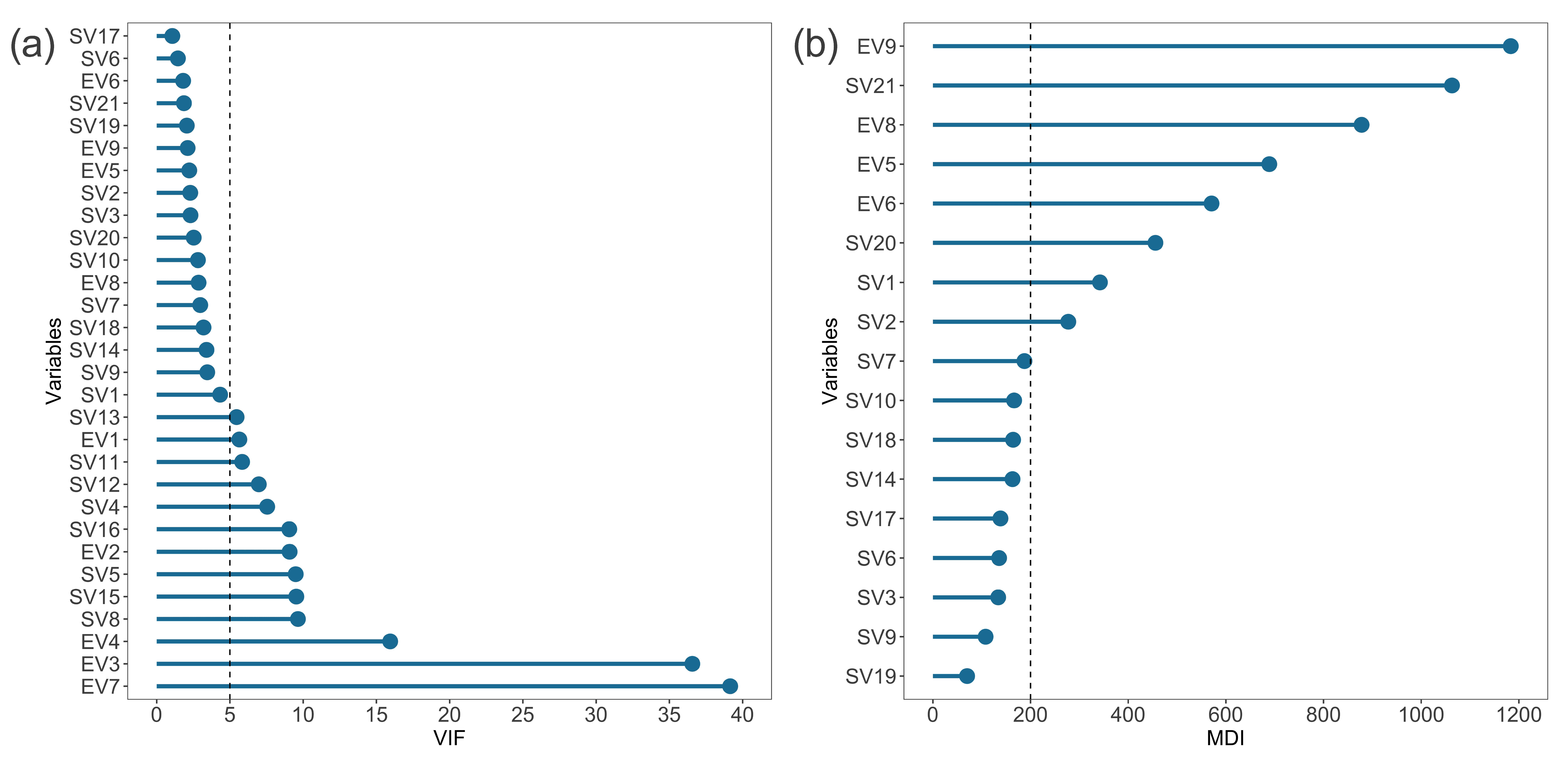
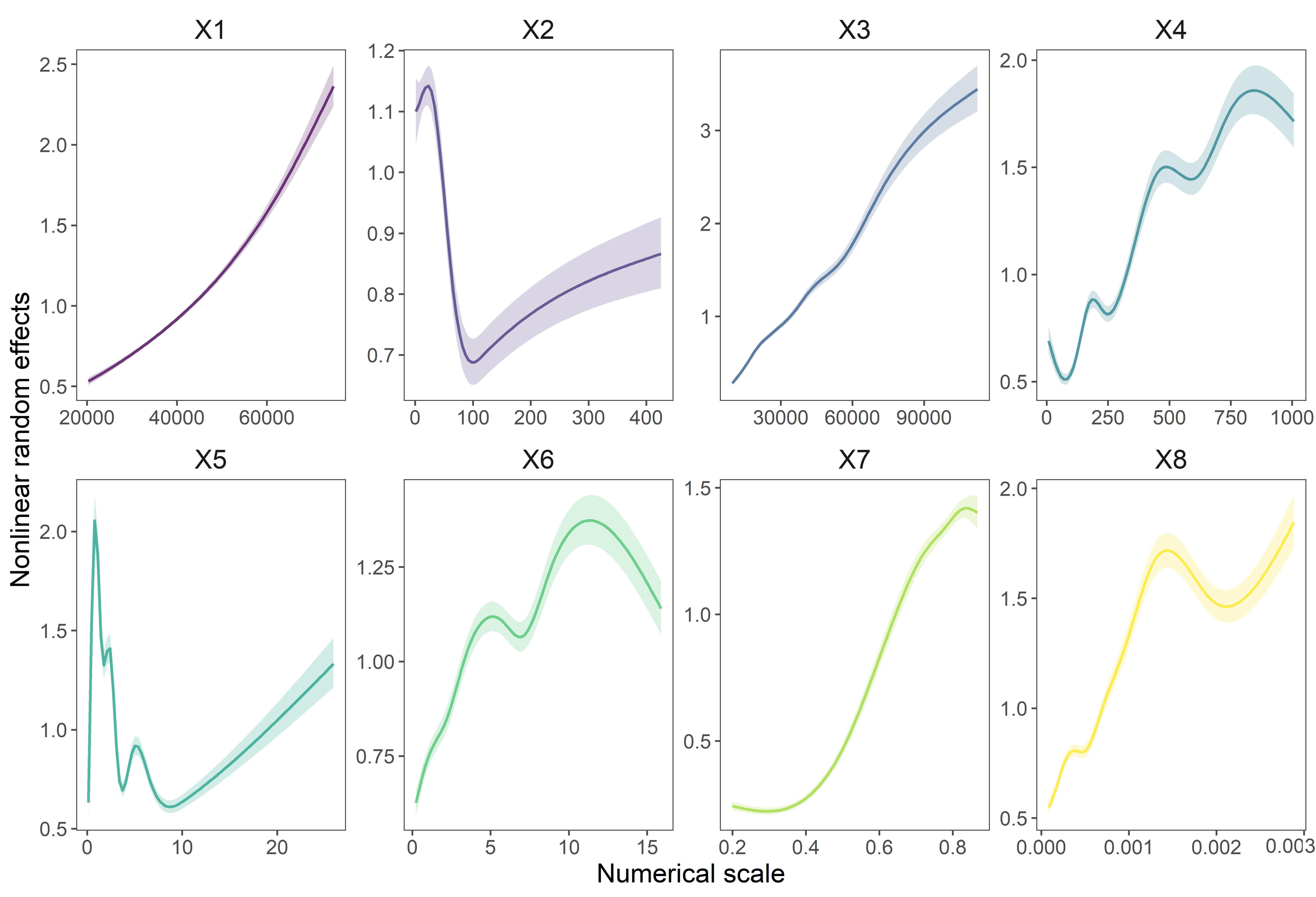
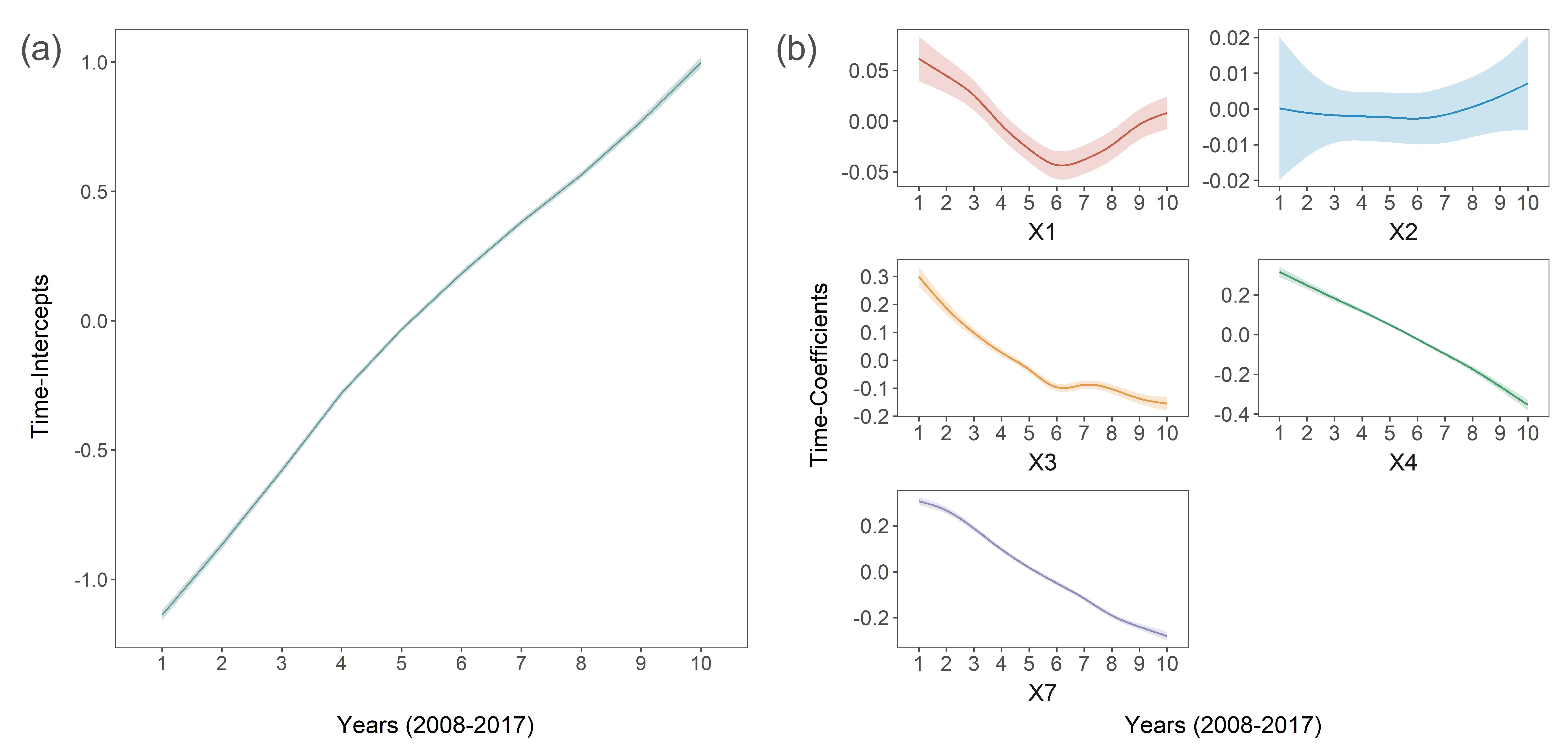
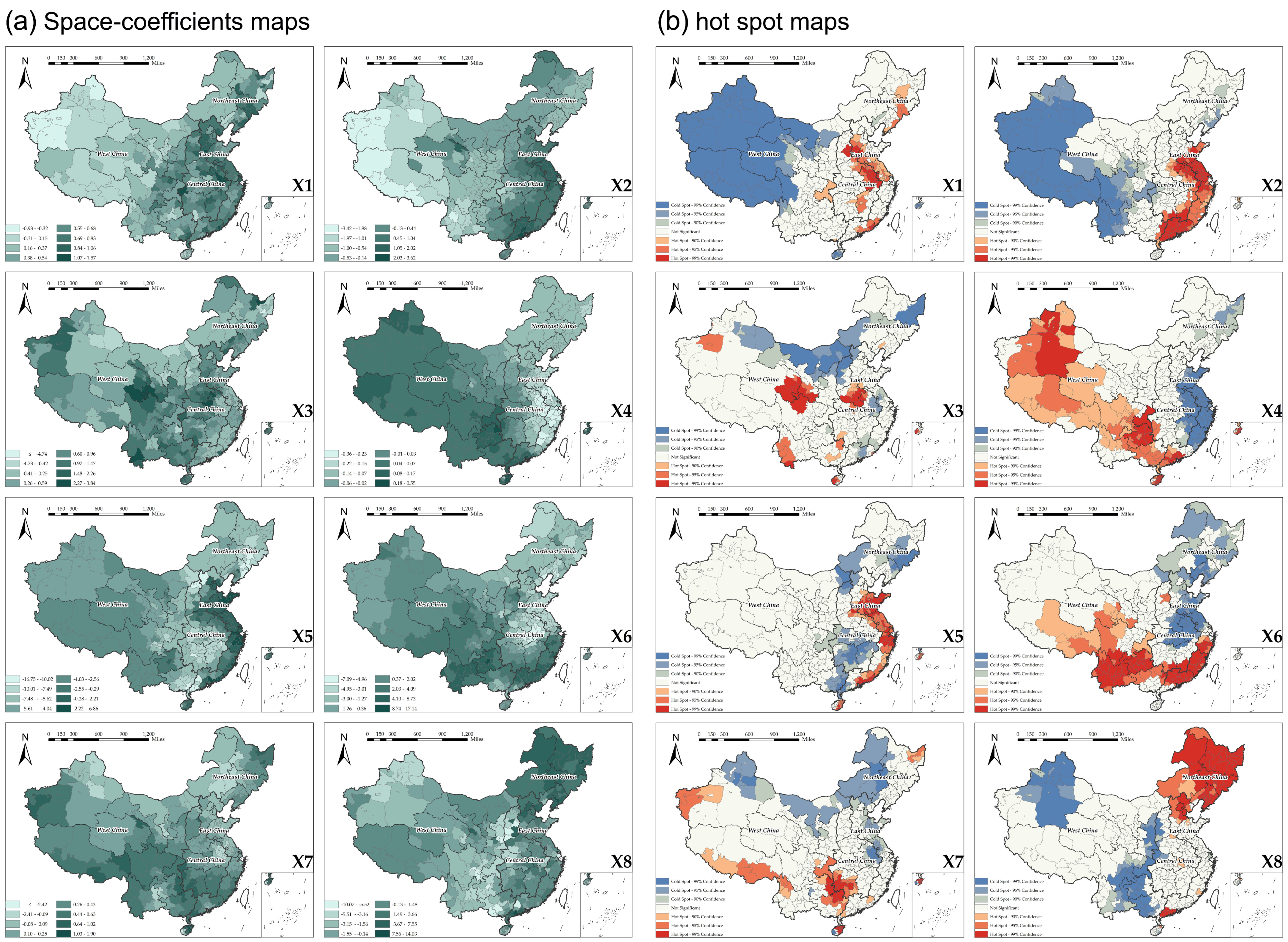
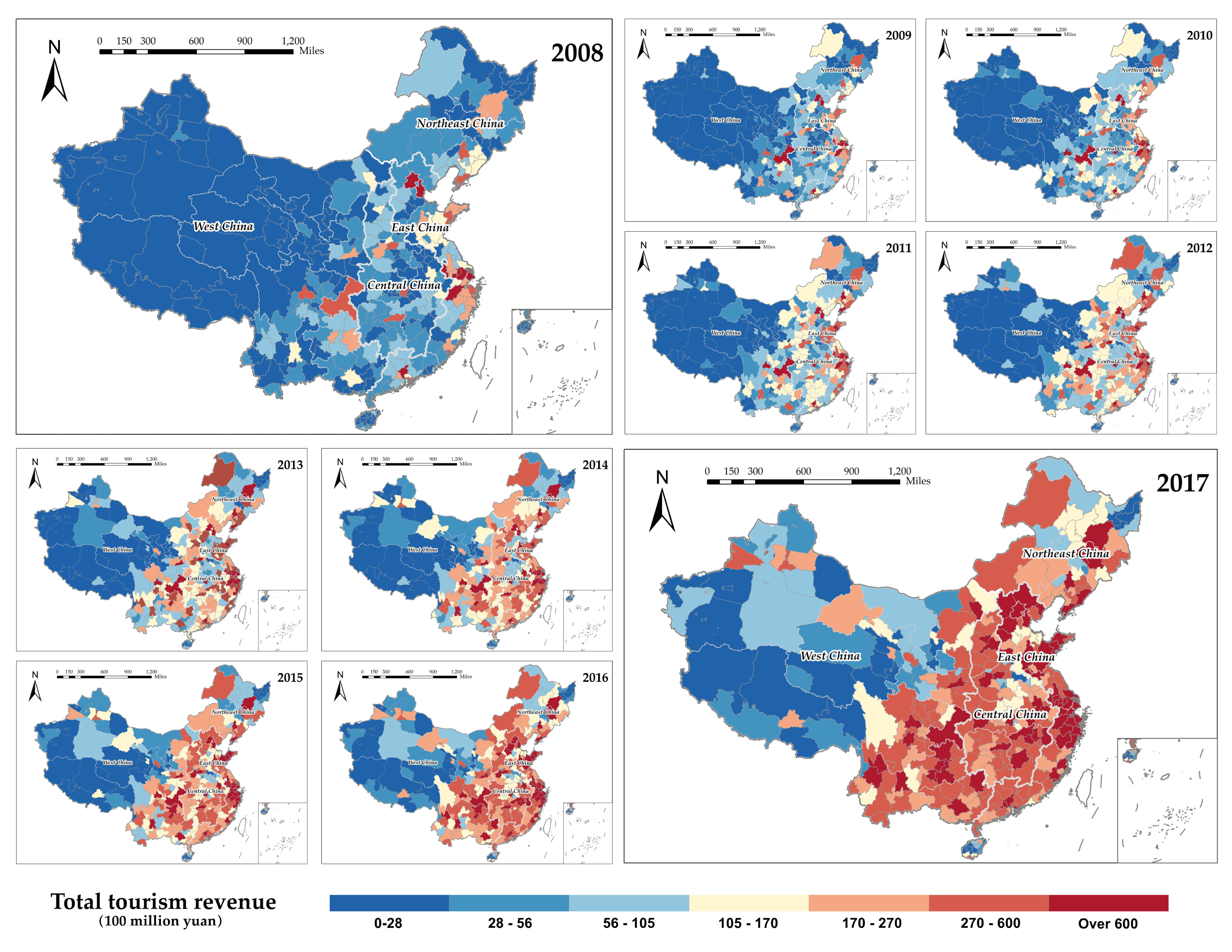
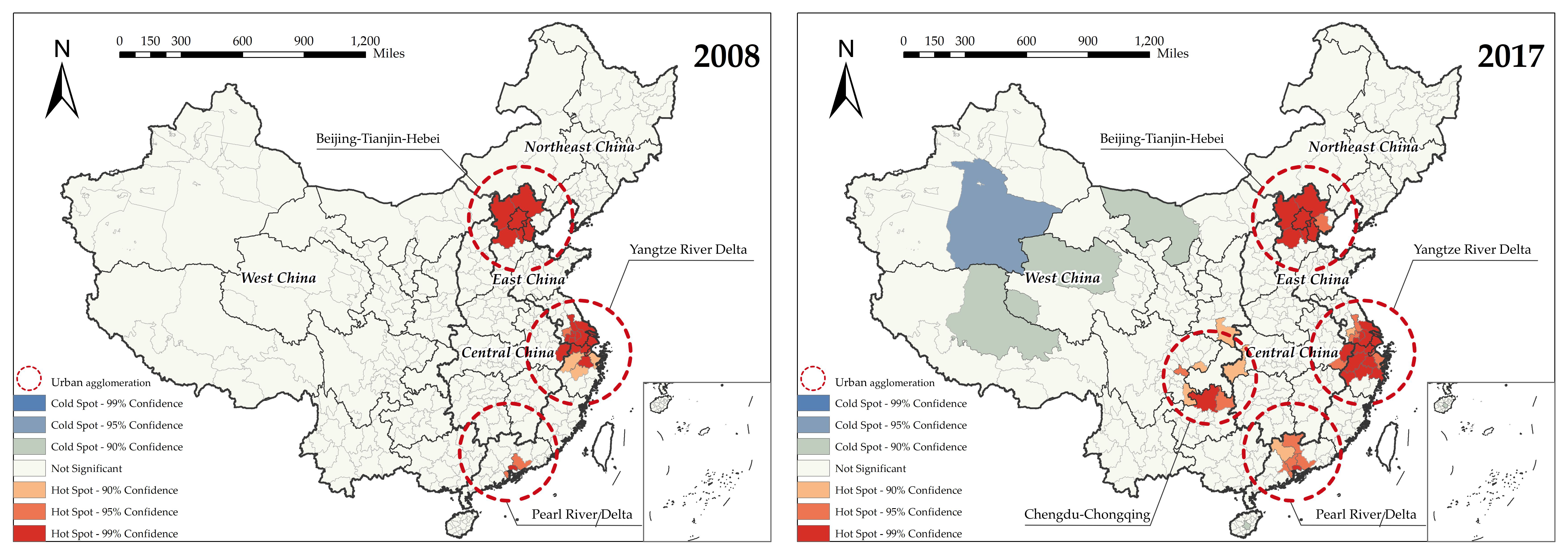
| Identifier | Socioeconomic Variables | Identifier | Environmental Variables |
|---|---|---|---|
| SV1 | Gross domestic product (GDP) per capita (yuan) | EV1 | Precipitation (0.1 mm) |
| SV2 | Population density (person/km2) | EV2 | Temperature (centigrade) |
| SV3 | Employment density of the first industry (person/km2) | EV3 | Air pressure (1 N/m2) |
| SV4 | Employment density of the Second industry (person/km2) | EV4 | Humidity (hPa) |
| SV5 | Employment density of the tertiary industry (person/km2) | EV5 | NDVI (/) |
| SV6 | Mobile phone penetration rate (subscriber/person) | EV6 | Road network density (km/km2) |
| SV7 | Internet broadband penetration rate (subscriber/person) | EV7 | Elevation (meter) |
| SV8 | Local general budget revenue per capita (yuan) | EV8 | Slope (°) |
| SV9 | Local government budgetary expenditures per capita (yuan) | EV9 | Nighttime light index (/) |
| SV10 | Employees population density (person/km2) | ||
| SV11 | Savings deposits of per capita residents (yuan) | ||
| SV12 | Loans of financial institutions per capita (yuan) | ||
| SV13 | Industrial enterprises density (number/km2) | ||
| SV14 | Social fixed asset investment per capita (yuan) | ||
| SV15 | Social consumable total retail sales per capita (yuan) | ||
| SV16 | Student’s density of ordinary middle school (person/km2) | ||
| SV17 | Student’s density of primary school (person/km2) | ||
| SV18 | Hospital density (number/km2) | ||
| SV19 | Hospital beds per capita (number/person) | ||
| SV20 | Employment density of urban units (person/km2) | ||
| SV21 | Average wage of employed persons in urban units (yuan) | ||
| Index | DIC | LS | WAIC | ||
|---|---|---|---|---|---|
| Model 1 | 40,238.39 | 9.02 | 5.97 | 40,262.83 | 30.05 |
| Model 2 | 39,153.72 | 64.89 | 5.81 | 39,157.01 | 66.83 |
| Model 3 | 31,825.74 | 348.95 | 4.72 | 31,848.15 | 338.66 |
| Model 4 | 30,307.19 | 899.21 | 4.52 | 30,345.55 | 761.76 |
| Variables | Socioeconomic and Environmental Aspects | Mean | SD | Q 0.025 | Q 0.975 |
|---|---|---|---|---|---|
| X1 | Average wage of employed persons in urban units | 0.4694 | 0.0212 | 0.4278 | 0.5110 |
| X2 | Employment density of urban units | −0.1428 | 0.0170 | −0.1761 | −0.1095 |
| X3 | GDP per capita | 0.4660 | 0.0258 | 0.4154 | 0.5165 |
| X4 | Population density | 0.2136 | 0.0282 | 0.1582 | 0.2689 |
| X5 | Nighttime light index | −0.0141 | 0.0310 | −0.0750 | 0.0467 |
| X6 | Slope | 0.1013 | 0.0202 | 0.0615 | 0.1410 |
| X7 | Normalized Difference Vegetation Index (NDVI) | 0.6630 | 0.0187 | 0.6263 | 0.6996 |
| X8 | Road network density | 0.3382 | 0.0226 | 0.2937 | 0.3826 |
Publisher’s Note: MDPI stays neutral with regard to jurisdictional claims in published maps and institutional affiliations. |
© 2021 by the authors. Licensee MDPI, Basel, Switzerland. This article is an open access article distributed under the terms and conditions of the Creative Commons Attribution (CC BY) license (https://creativecommons.org/licenses/by/4.0/).
Share and Cite
Zhang, X.; Song, C.; Wang, C.; Yang, Y.; Ren, Z.; Xie, M.; Tang, Z.; Tang, H. Socioeconomic and Environmental Impacts on Regional Tourism across Chinese Cities: A Spatiotemporal Heterogeneous Perspective. ISPRS Int. J. Geo-Inf. 2021, 10, 410. https://doi.org/10.3390/ijgi10060410
Zhang X, Song C, Wang C, Yang Y, Ren Z, Xie M, Tang Z, Tang H. Socioeconomic and Environmental Impacts on Regional Tourism across Chinese Cities: A Spatiotemporal Heterogeneous Perspective. ISPRS International Journal of Geo-Information. 2021; 10(6):410. https://doi.org/10.3390/ijgi10060410
Chicago/Turabian StyleZhang, Xu, Chao Song, Chengwu Wang, Yili Yang, Zhoupeng Ren, Mingyu Xie, Zhangying Tang, and Honghu Tang. 2021. "Socioeconomic and Environmental Impacts on Regional Tourism across Chinese Cities: A Spatiotemporal Heterogeneous Perspective" ISPRS International Journal of Geo-Information 10, no. 6: 410. https://doi.org/10.3390/ijgi10060410
APA StyleZhang, X., Song, C., Wang, C., Yang, Y., Ren, Z., Xie, M., Tang, Z., & Tang, H. (2021). Socioeconomic and Environmental Impacts on Regional Tourism across Chinese Cities: A Spatiotemporal Heterogeneous Perspective. ISPRS International Journal of Geo-Information, 10(6), 410. https://doi.org/10.3390/ijgi10060410






